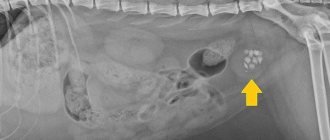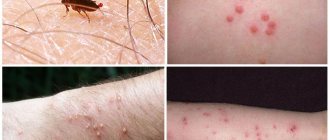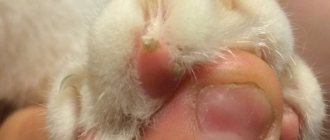March 3, 2021
Cryptorchidism in dogs is essentially the same as in cats. In this article, using cats as an example, we will look at the problem as a whole. Cryptorchidism in cats is a pathology of the male reproductive system, in which one or two testes do not descend into the scrotum. Based on this parameter, cryptorchidism is divided into unilateral (one-sided) or bilateral (two-sided).
There are also isolated cryptorchidism, in which only this pathology is present in the cat, and combined, accompanied by other disorders in the structure and functioning of the reproductive system. In cats, this disease is less common than in dogs; the prevalence is estimated at 1.3-3.8% of males in the population.
Types of cryptorchidism
The type of cryptorchidism depends on the location of the testes that have not descended into the scrotum. The usual places for their localization are: the abdominal cavity (abdominal cryptorchidism), the inguinal canal (inguinal cryptorchidism), outside the abdominal wall under the skin (subcutaneous localization). Sometimes the last two localizations are combined under the form of inguinal cryptorchidism. Some researchers associate the type of disease with the stage of development and movement of the testes in the embryonic period in which the disorder occurred.
The testes, located in the inguinal canal or under the skin, can be fully developed and produce testosterone and sperm, which is why it is so important during castration to determine the location of both testicles and remove them.
The testes located in the abdominal cavity are, as a rule, underdeveloped, small in size, and unable to synthesize hormones and germ cells, since the conditions for their formation are very different from natural ones. Bilateral cryptorchids with both testes located abdominally are often infertile.
In the abdominal form of cryptorchidism, the testicle is located in the abdominal cavity in the space between the kidneys and the internal inguinal ring, depending on at what stage of movement it stopped. Incomplete abdominal cryptorchidism also occurs, in which the epididymis of the testis bypasses the internal inguinal ring, and the testicle itself remains in the abdominal cavity, usually near it.
In conditions of inguinal cryptorchidism, the testis remains in the inguinal canal, between the inner and outer rings; its position is important to accurately determine before surgery.
With a subcutaneous location, the testis is usually located in the femoral triangle (an area bounded by two muscles and the inguinal canal), and may be located near the underdeveloped scrotum.
Benefits of the procedure
Owners are not always ready to neuter their pets. Men may be especially hostile to this procedure. Despite outbursts of feelings of solidarity and concern for the safety of the cat’s personality, castration is still worth carrying out if the animal is not intended for breeding. The operation relieves the male of suffering caused by unrealized sexual instinct. The owner gets a calmer pet and does not have to worry about regular screams and smelly marks in the apartment (house).
Removing the testes or stopping their work does not always radically change the behavior of the animal. It is believed that a neutered cat turns into a lazy carcass, focused only on food. In reality, the male often retains his previous character traits such as playfulness and activity. Aggression provoked by the production of male sex hormones is significantly reduced. Castration, like sterilization of females, potentially prolongs the life of a pet, reducing the risk of developing diseases of the genitourinary system. The procedure reduces the cat's activity, so that he is less likely to want to go outside. That is, the likelihood of a male dying under the wheels of a car or in a fight for a partner decreases.
Causes of cryptorchidism in cats
Cryptorchidism is a relatively long-known disease. Initially, non-descent of the testes into the scrotum was considered as a single pathology with a common cause, but over time the approach to classification has changed. At the moment, many researchers are inclined to consider cryptorchidism in cats as a phenotypic manifestation of various anomalies in the development of the reproductive system, as one of the components of syndromes associated with abnormal development of the testes.
At this stage of medical development, it is known that the process of descent of the testes into the scrotum is complex, takes place in three phases, and is regulated by a large number of structures. Anatomical structures and male sex hormones are involved in the process, and a failure in various elements of this complex system can cause the appearance of cryptorchidism.
Since the development and functioning of all these components is genetically predetermined, it was experimentally revealed that by blocking the function of genes responsible for the development of structures involved in the movement of testes from the abdominal cavity to the scrotum, cryptorchidism can be caused in an animal. Also, a similar effect was achieved by blocking the function of testosterone, which affects the formation of some structures responsible for the descent of the testicles into the scrotum.
Thus, it has now been revealed that this pathology is associated with the presence of disorders in various genes and has a complex system of recessive inheritance. In addition, it is likely that the development of cryptorchidism in rare cases may be associated with intrauterine causes - exposure to external factors on the fetus during pregnancy. Unfortunately, a complete picture of the genetic causes of the disease has not yet been formed; research is still being carried out. In animals, the situation is complicated by the fact that the most promising research methods, in particular molecular ones, are not available to veterinary medicine.
Caring for a cat after castration
After castration, the animal needs rest. To prevent the surgical suture from licking, it is recommended to wear a protective blanket or collar. After the operation, the surgeon will prescribe antiseptic solutions and ointments for treating the sutures. It is necessary to ensure that the seams are always dry and clean. If redness and soreness of the tissues around the suture, or discharge of pus or blood from the suture appears, immediately show the cat to a veterinarian!
Sutures are removed 10-14 days after surgery.
The only measure to prevent cryptorchidism in cats is to exclude cryptorchid cats from breeding.
(c) Veterinary center for the treatment and rehabilitation of animals “Zoostatus”. Varshavskoe highway, 125 building 1. tel. 8 (499) 372-27-37
Diagnosis of cryptorchidism
As a rule, if the testis is inguinal or subcutaneous, its location can be identified by palpation, however, if the testicle is located in the abdominal cavity of a cryptorchid cat, additional diagnostics are usually required in order to determine its presence and so that when removing it, the surgeon knows the area , in which you need to look for the desired organ.
In some exceptional cases, hormonal stimulation methods can be used to determine the presence of hormone-producing testes in a cat: when using this method, the animal is injected with a certain dose of a hormone that stimulates the secretion of testosterone, and the presence of functioning testes in the body is determined by changes in its amount in the blood.
Features of cryptorchid sterilization
The cost of castration will be several times higher. This is not a whim of greedy veterinarians. Considering that the “lost” testes are (most likely) in the abdomen, abdominal surgery is required. It involves the mandatory administration of general anesthesia (which in itself is not cheap), the procedure takes many times longer.
Please note that preparation for surgery requires keeping your pet hungry for 12 hours. Another 3 hours before the procedure, the animal should not even be given water.
But sometimes you can get by with a little bloodshed. So, in some cases, the testicles are located close to the exit to the scrotum and can descend there when the cat is under severe stress, or when it is completely relaxed. In such situations, massage of the genital area helps: the testis comes out, it is “caught” and fixed using a loose ligature or elastic band placed on the scrotal sac of the scrotum.
But the main feature of castration of cats is the need for a preliminary medical examination. Using radiography and ultrasound, it is necessary to find out exactly where the organ is located. There are cases when the testicles only slightly did not reach the entrance to the scrotum, being located directly at the inguinal ring. But sometimes they are located deep in the abdominal cavity. Data obtained from research is used to plan surgery.
How to check your cat yourself
The location of the gonads in males differs from their location in females. This is due to the conditions for spermatogenesis (the formation of male sex cells) - it requires a lower temperature, so the testes are moved outside the abdominal cavity, where the temperature is very high.
Normally, the testes descend into the scrotum before the 10th day after the cat is born; at the age of puberty (7-8 months), the inguinal ring closes and the testes can no longer move out of the scrotum. If at the age of 8 weeks both testicles are not palpable in the scrotum, or if at the age of 9 months or more the testis can change its location - either descending into the scrotum or disappearing from it - cryptorchidism is diagnosed.
It is important to monitor the presence of testes in the cat's scrotum from the moment he arrives in the house. If the scrotum is empty, or only one round formation can be felt in it - the testis, or if the kitten has matured, but one or both testicles are in the scrotum, then no - this is a reason to consult a veterinarian for further diagnosis of possible cryptorchidism. You can also attend routine veterinary examinations, during which it is necessary to check whether the cat is cryptorchid.
Timely detection of the disease is extremely important, since the testes located in the abdominal cavity of a cryptorchid cat can degenerate into a cancerous tumor under unnatural conditions at higher temperatures. Also, due to the loose location of the testis outside the scrotum, torsion of the testicle and spermatic cord may occur, which will cause severe pain in the cat and a number of possible unpleasant complications. Drug treatment of cryptorchidism has shown to be ineffective, and the only way to correct this pathology at the moment is surgery.
How to identify the problem: main signs
The owner may not find out about the cat’s illness, since he does not experience problems during mating.
Owners are not always able to immediately determine that a cat is cryptorchid, especially if the animal is still very small. It is possible to understand that a pet’s testicles are not descended after 6 months of birth. In most cases, the disease is detected visually or by palpation. Often, with an advanced disease, an animal has a hard testicle or the owners note that it is swollen and an unpleasant-smelling discharge appears. But sometimes difficulties arise in identifying cryptorchidism, since the cat is sexually active and the symptoms of the disease do not affect mating in any way. If the disease is bilateral, then spermatogenesis is absent.
Is it possible to remove only one testis?
No, such an operation is not performed. Cryptorchidism is a genetic disease, the prevalence of which can only be reduced by excluding affected individuals and carriers from breeding. If a sick cat is found in the litter, the breeder must decide to exclude the cryptorchid, as well as its parents, from breeding, since they are carriers of the disease.
Despite the fact that pathology can only manifest itself in males, females, without suffering from the disease due to the different structure of the reproductive system, can be carriers. If cryptorchid appears repeatedly in the litters of a parent couple, siblings (littermates) of sick cats are also excluded from breeding. Since the testes of a cat perform one function - participation in the reproduction process - cryptorchid must be castrated.
If you remove only the testis that has descended into the scrotum, then the remaining testicle in the abdominal cavity or pelvic area may eventually degenerate into a malignant neoplasm. In addition, the testes located in the groin area may well function and produce testosterone, causing unwanted sexual behavior in cryptorchid, so a cat with one testicle that has not been removed may behave in the same way as one that has not been castrated.
How to care for an operated animal
If after regular castration caring for a pet is relatively simple, then in this case much more is required from the owner of the animal. Thus, it is necessary to ensure complete cleanliness of the postoperative wound, for which the pet should not be allowed outside. At least once every three days it is necessary to bring the cat to change the bandages.
The animal should be kept in a separate room with a minimum of furniture. Chests of drawers, chairs, bedside tables, etc. must be removed from there. This is due to the fact that the cat may try to jump on them, and this can lead to the seams coming apart.
The condition of the seams should be monitored daily. If redness, foul odor and/or pus appear, call your veterinarian immediately. You should not take your pet to the clinic, as in this condition the trip could end badly for him.
After castration, the animal is fed only high-quality, easily digestible food.
On the first day, it is advisable to limit your pet to only light chicken broths, which can be flavored with a small amount (very small) of finely chopped low-fat offal. It is allowed to include a small amount of boiled vegetables put through a blender into the post-operative diet. They contain fiber that stimulates peristalsis. This is a good prevention of constipation, which is often found in pets who have undergone abdominal surgery.
How is the operation performed?
The complexity and technique of the operation will depend on the location of the testis. If the testicle of a cryptorchid is located under the skin in the groin area, and it can be moved to a normal anatomical position, the operation will not differ from routine castration: the cat is anesthetized by intravenous injection of the drug into a catheter, then through small incisions on the scrotum The testes are removed, a biological node is applied to the spermatic cord, and the testes are removed.
If the testis is deeper, a lower midline incision is made along the linea alba, the inguinal fat deposits and external inguinal ring are examined, the testis is removed, the spermatic cord is ligated, the testis is cut off, and then the remaining testicle is routinely removed. A suture is placed at the incision site. If the testicle is located in the abdominal cavity, a full-fledged abdominal operation is performed, comparable in invasiveness to castration of the female, since the organ of the reproductive system is also located in the abdominal cavity. In this case, gas anesthesia is used and a suture is necessary on the incision area.
Treatment options
It should be said right away that cryptorchidism is not capable of leading a mustachioed pet to death, but this does not mean that it does not need to be treated. Drug therapy is used extremely rarely and does not provide a long-term positive effect. For this purpose, hormonal drugs containing testosterone are usually used. Please note that giving them to a small cat is strictly prohibited, since this hormone negatively affects the hypothalamus of a furry baby, and also slows down the growth of bones in the growing body.
Doctors are convinced that castration of a cryptorchid cat is the best therapeutic option of all possible. The operation will suppress the animal’s reproductive aspirations, and will also relieve it from the risk of neoplastic degeneration of a testicle that has not descended into a malignant neoplasm. Statistical studies have shown that the ideal age to castrate a cat is 7-8 months. Before this, you need to conduct diagnostic studies, including a general analysis of the blood fluid and an ECG, which allows you to rule out heart problems in your pet.
Sterilization of cryptorchid involves abdominal surgery, lasting 1.5-2 hours. During this procedure, the cat is placed under general anesthesia. Surgical techniques vary depending on the type of cryptorchidism.
Inguinal cryptorchidism
The first step is for the veterinarian to shave the patient's fur at the site where the incision will be made. Then the skin and fatty tissue is dissected, and the undescended testicle is completely removed. The spermatic cord is cauterized with a coagulator at the cut-off site or tied into a knot. The last stage is suturing.
After the operation, it is necessary to protect the cat from licking the sutured incision. To do this, it is worth purchasing a special collar at the veterinary store that prevents such an instinctive reaction. This must be done, since along with saliva, the pet can introduce pathogenic bacteria into the wound that has not yet healed, which can lead to inflammatory processes and suppuration. It is also recommended to treat the sutures with an antiseptic, for example, Chlorhexidine, until the sutures are completely healed.
Abdominal cryptorchidism
The operation is in many ways similar to conventional sterilization. A laparotomy procedure is performed along the linea alba of the abdomen, thus revealing the vas deferens, usually located in close proximity to the neck of the bladder. After which the testicle is stretched out and removed, then sutures are applied.
After castration, owners can leave the cat in a hospital, under the supervision of a doctor, or take it home. The second option requires careful and proper care of the operated animal. Basic rules of care include:
- there should be no drafts in the room where the pet is;
- a collar is put on the cat, its stitched wounds are treated with antiseptic agents;
- the owner must monitor the slightest increase in the animal’s body temperature. If it has risen, then you should give him Ketoprofen, calculating the dose depending on the weight of the pet. Under no circumstances try to bring down the fever with “human” medications such as Analgin or Paracetamol, they can provoke an allergic reaction in your furry friend, and even kill him;
- if a castrated cat does not show any interest in food for 2-3 days, then take him to a specialist for examination;
- Often one of the side effects of surgery is problems with bowel movements in cats. If the animal cannot go to the toilet for more than 2 days, then use Vaseline oil. It has a mild laxative effect.
Keep in mind that after surgery, the doctor may additionally prescribe the cat a course of vitamins, as well as hemostatic and antibiotic drugs. It is important to carefully follow all the advice of the treating veterinarian; this will reliably protect the cat from complications and allow him to get back on his feet faster.
Finally, I would like to say that cryptorchidism is not a death sentence for a meowing pet. Even with an undescended testicle, he will fully exist and delight his owners. Castration will help you get rid of the anomaly 100%. After it, the animal becomes calmer, stops marking its territory and does not experience anxiety about satisfying its reproductive instincts.
Postoperative care
With routine castration, postoperative care is simple: since no suture is placed, no specific care of the incision area is required. The incision usually heals within a few days. During this period, it is important to exclude the possibility of the cat licking the scrotum area; it is advisable to monitor him at least in the first few hours after the operation. The cat's tongue is covered with sharp papillae and is very rough, which is why the wounds that the cat licks are very damaged.
If your pet shows interest in the incision site, you need to put a protective collar on it. It is necessary to change the filler and wash the tray so that contaminated surfaces come into contact with the wound as little as possible. It is advisable to limit physical activity as much as possible on the day after surgery, let the cat jump on various surfaces as little as possible and lie on a cold floor.
In addition, it is necessary to reconsider the pet’s diet: if the cat ate industrial food, after the operation it is advisable to switch to a diet for castrated cats; if he ate natural food, it is necessary to reduce the caloric content and energy value of the food consumed. Since after castration, due to a decrease in the amount of testosterone, cats begin to spend less energy, and due to an increased interest in food, they eat more, insufficient attention to the amount and composition of food offered to the cat can lead to obesity in the future.
If a cat has had a testicle located in the abdominal cavity removed, it is necessary to monitor the condition of the suture for 10 days and wear a blanket and a protective collar. A few days after the operation, you need to untie the last two or three knots on the blanket and inspect the seam area. If the condition of the suture or the cat’s well-being is of concern, you can always seek advice from the surgeon who performed the operation.
Back
Rehabilitation after surgery
When taking an animal home after surgery, the owner should be aware of some rules that will allow rehabilitation to be carried out quickly and with minimal discomfort for the cat.
Firstly, you need to prepare in advance the place where the cat will be for the first hours after the operation. The animal is protected from drafts and excessively hot radiators. Fine. If you manage to restrict your pet’s movements using a carrier or cage, the cat will feel insecure when recovering from anesthesia and may get injured.
During the first hours after recovery from anesthesia, the cat should be monitored or placed in a cage.
You need to carefully monitor your pet's condition, reporting any negative changes to your doctor. If the cat refuses to eat for the first day or two, it's not a big deal. If the animal continues to ignore food, behaves lethargically and is not interested in anything, this is a reason to urgently visit a doctor.
Another common side effect of abdominal surgery in cats is the absence of bowel movements. To help your pet, you can give him a teaspoon of Vaseline oil, which acts as a mild laxative. But, it is worth using it on the third or fourth day if the cat was still unable to defecate on its own.
The oil can be mixed with food or administered into the cat's mouth using a rubber bulb.
You must also carefully follow the individual recommendations of your veterinarian. The cat may be prescribed hemostatic drugs, anti-inflammatory or antibiotics, and vitamins.











